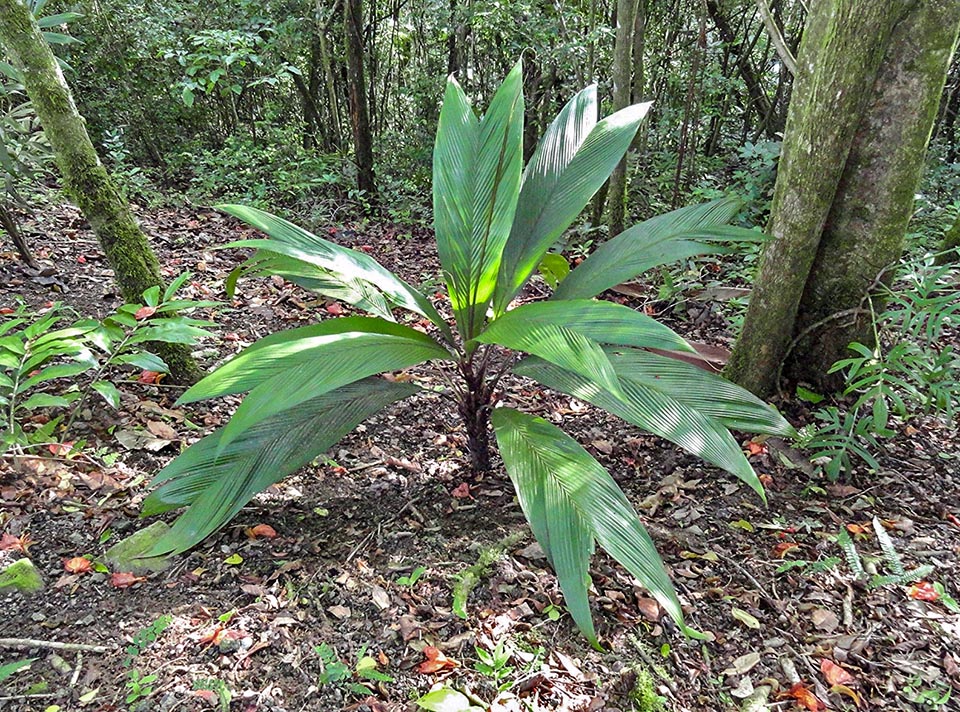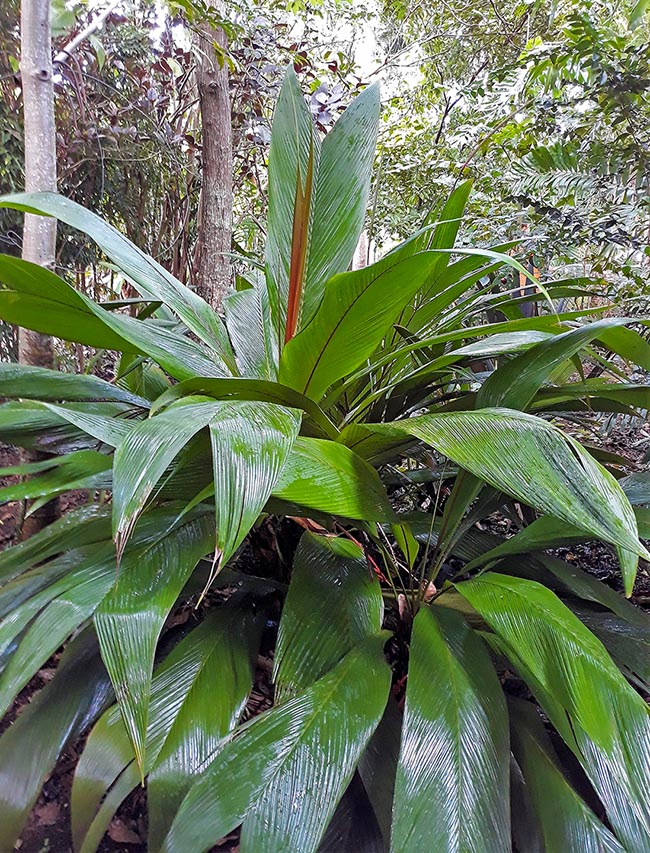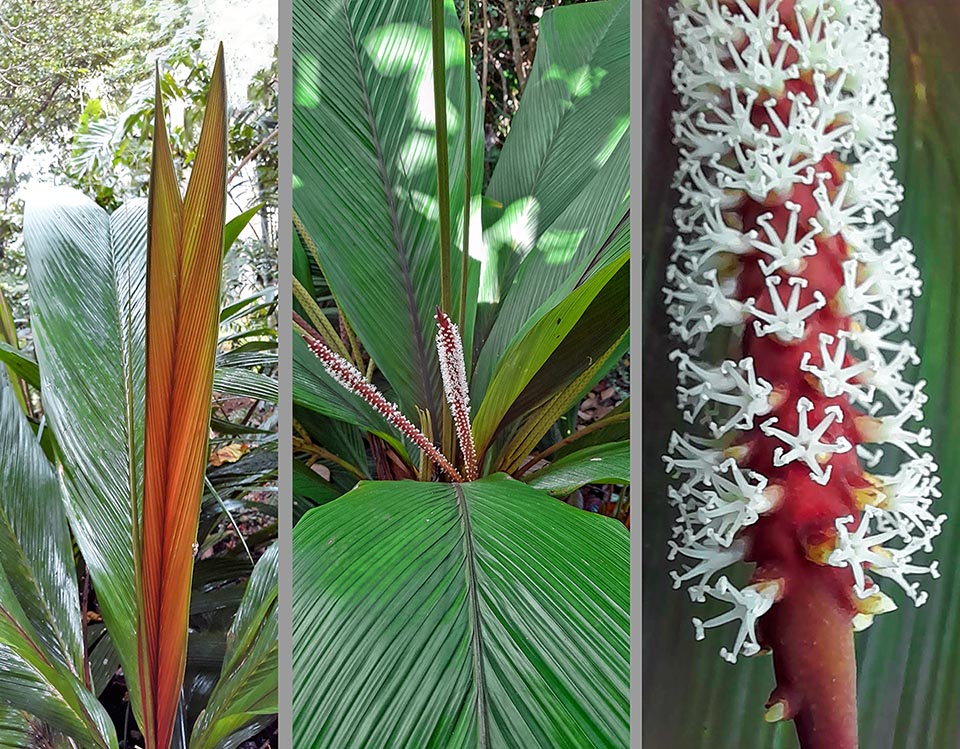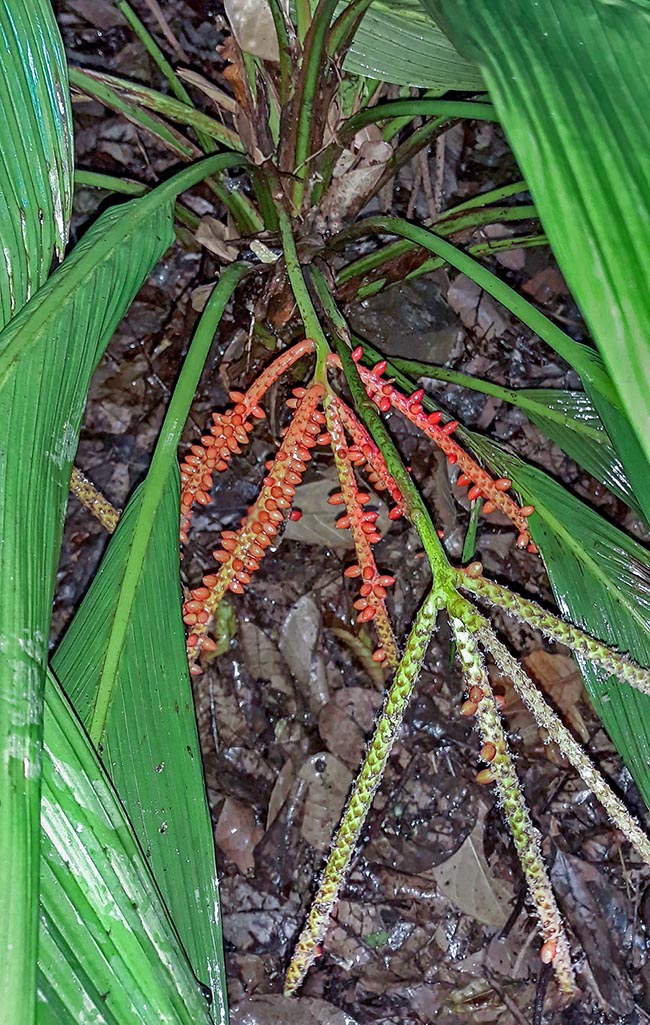Family : Arecaceae

Text © Alessandro Marini

English translation by Mario Beltramini

Native to Central America, Asterogyne martiana H. Wendl. is a palm typical of the undergrowth of the pluvial tropical forest © Jardin Boricua
Asterogyne martiana H.Wendl. is very diffused in Central America and displays an ample distribution area going from Colombia to Costa Rica up to Ecuador, Belize, Guatemala, Honduras, Nicaragua and Panama.
It is a palm typical to the undergrowth of the tropical rainforest, where it is fairly common and is widely distributed up to 500 m of altitude, but Colombia where it can reach even 1100 m.
Tha name of the genus Asterogyne refers to the star-shaped female flowers and comes from the Greek terms “ἀστήρ” (astér), star and “γυνή” (gyne), female.

Of contained size, it has thin solitary stems that can reach 2 m of height. The crown, about 2,5 m broad, is formed by 8 to 18 bifid leaves, deeply divided at the apex, vertical initially, then tending to arrange themselves horizontally © Sylvie Maillot
The name of the species martiana honours the German naturalist and botanist Carl Friedrich Philipp Martius (1794-1868), Professor at the University and Director of the Botanical Garden of Munich, who explored the Amazon, from where he brought hundreds of samples of animals, plants and seeds.
This species is the most widely diffused of the genus Asterogyne.
Common names: Cortadera, Rabihorcao (Colombia), Pico (Ecuador), Capoca (Guatemala), Pacuquilla (Honduras), Pata de gallo (Nicaragua), Polaris palm (English).
Palm of contained dimensions, has thin solitary and green stems that may reach 2 m of height, with a maximum diametre of 4/5 cm.
The stems can often have an underground or prostrate development, in this last case they can emit roots in the points of contact with the soil. It can also present small aerial roots at the base of the plants. In the biggest specimens the stems are often covered by the remainders of the old leaves.
The foliar crown is formed by 8 to 18 leaves and has a diametre of 2,5 m. The new leaves have a vertical posture whilst the oldest ones tend to arrange themselves horizontally.
The leaves are entire, bifid and deeply divided at the apex in two wide pointed segments. They are up to 1 m long, and up to 30 cm broad, and have prominent veins in relief, transversal to the rachis that correspond to not aborted innate foliar segments. Usually, they are entire, but exceptionally they can result divided on both sides in 2 or 3 very wide foliar segments, with evident thick veins.
The leaves are dark green above and pale green below. The new emerging leaf has a colour variable from yellow to orange, from pink to red. The rachis is green on the upper pagina of the leaf and is thicker and darker, tending to brown, on the lower one.
The petiole is smooth and short in respect to the size of the leaf blade, up to 15 cm long and has brown fibr.es on the edges around the base.

The leaves are bifid, deeply divided at the apex. The emergent ones have orange shades. Inflorescence and flowers close-up © Sylvie Maillot
Asterogyne martiana is a monecious species. The inflorescence develops at the base of the leaves and is 50 to 80 cm long and has colour variable from orange to brown.
The inflorescence ramifies in the apical part of the petiole in 3/8 straight racemes, 15 to 25 cm long, with a diametre of 4 to 8 mm.
On the inflorescence are present triads of 2 male flowers and 1 female arranged in distinct longitudinal rows. The male flower has 6-24 stamens. The female one is star-shaped, hence the name of the genus. The blooming of the male and female flowers is synchronized with phases well spaced in the time.

The green, red and then brown fruits are black when ripe. Born for tropics, but possible indoor plant © Sylvie Maillot
The plants may appear unisexual as the male flowers are rather shelved and are not evident during the female blooming.
In the countries of origin, the blooming occurs most of the year and the pollination is provided by various species of insects of the family of the Syrphidae.
The colour of the unripe fruit varies from green to purple to brown and is black when ripe. It is smooth ovoidal or ellipsoidal and is up to 1,2 cm long with a diametre up to 0,5 cm and presents a homogeneous endosperm containing only one seed.
Asterogyne martiana is the only one among the 5 species of the genus Asterogyne to be widely known especially due to its ample distribution range. Consequently, it is quite diffused in cultivation and can be admired in public parks and private gardens all over the tropical belt.
It easily reproduces by seed that germinates easily in 1 or 2 months on a warm bed.
The species can be very well utilized in the small gardens because of its contained dimensions, but needs shady positions, sheltered by trees and shrubs, as in nature. In order to maintain undivided the leaves, the same must be sheltered against the winds, placing them in protected locations.
It is a perfect candidate as indoor plant or for small greenhouses and winter gardens guaranteeing a good environmental humidity and natural light.
The cultivation soil must be very draining because this species does not stand humid soils and water stagnations, not even frequent watering. For this purpose, can be utilized a mix of loam with river sand, agri-perlite, and other inerts such as the lapilli.
Although of tropical origin, Asterogyne martiana has shown a good resistance to cold in cultivation, standing lowest temperatures up to 4 °C, even if occasionally and for short time. However, it is a species cultivable only in subtropical or warm temperate climates, where it never freezes and the cool periods are limited in the time.
The leaves are often collected by the local populations as cover for the hut’s roofs, seen their long duration.
Synonyms: Geonoma martiana H.Wendl.; Geonoma trifurcata Oerst., Vidensk. Meddel.; Asterogyne minor Burret.
